Theo Verelst Local Diary Page 20
The same holds as for my tripod and
other diary pages: nothing on this page may be copied or changed and
distributed except that the page as a whole may be printed or otherwise
transfered in unchanged form, mentioning the original URL
and global page reference, and that holds for everyone on the globe
and beyond, including so called 'christians' and self-appointed 'Secret
Services'.
Home (alt) Tripod Home Local Diary list (Secure) Tripod Diary
List Previous Diary
Tue Nov 2 14:32 2004
Sitting in the cantine area near a of course seriously expensive coffee
stand, luckily enabled to have some coffee and a sausijzenbroodje
(wouldn't now for the life of me what that is in english) I'm thinking
about the medical library magazine info I just gathered in the Leiden
Academic Hospital.
I didn't know there was such library, but assuming its probably the
most prestigeous dutch academic hospital and university city, well,
eehr, used ot be, I though it would have a pretty steep academic
library, and indeed there is.
About half the magazines I knew about in the area of lets say
neurology, cell biology, and nanobiology/chemistry, and I'm still
skimming through some I didn't know.
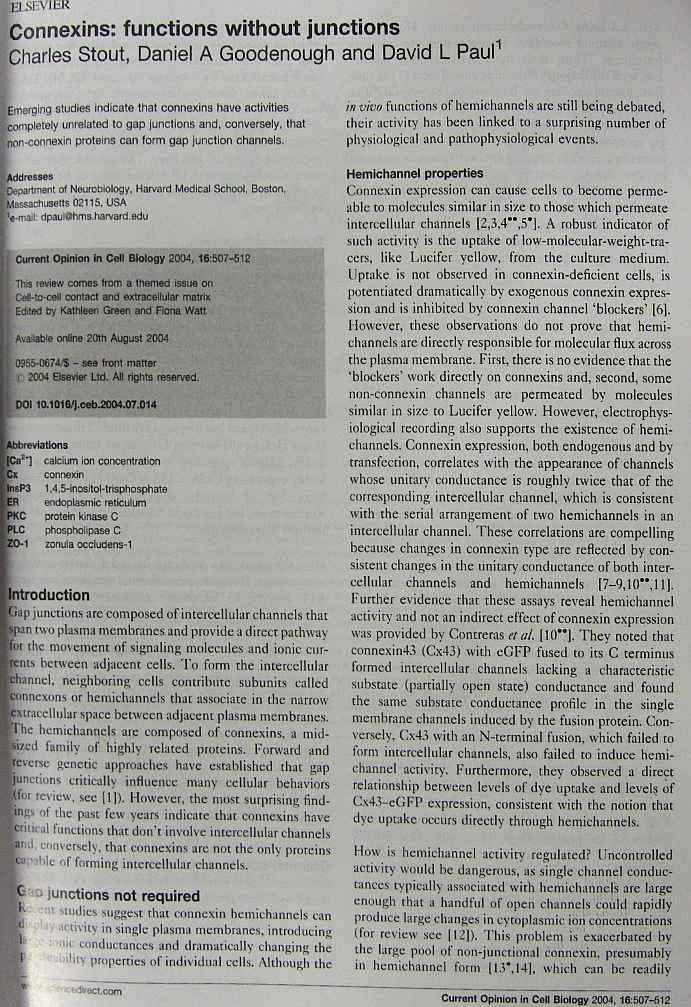
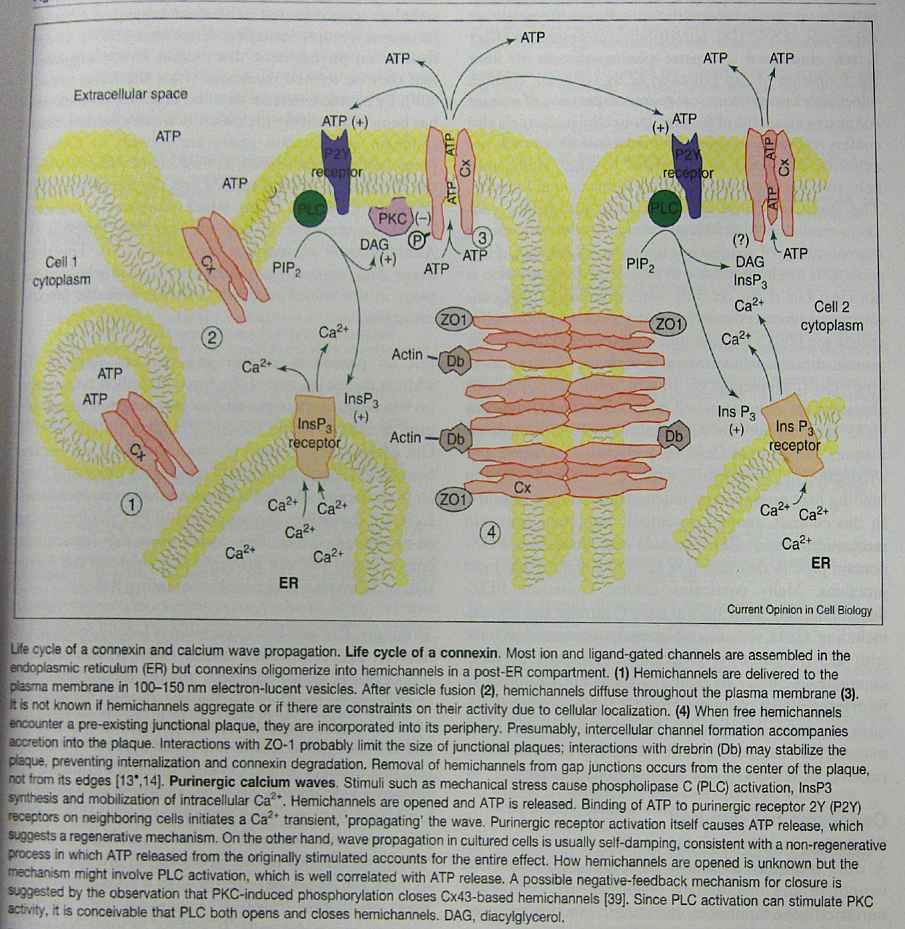
At Leiden university library I've looked at some recent dutch
magazines, and I found a historical magazine (a magazine about history)
"The Journal of Israeli History" , politics, Society , Culture Vol
20, Summer Autumn 2001. This is from a dutch acedemic magazine:

Nov. 23 2003, 18:06
Well, at least some activity, though hardly at the level I could be at
a decade ago, technically/scientifically speaking, but nevertheless
some interesting ongoings.
First, I had made a wonderfull page on the tcl-er's
wiki, about a well chosen subject 'The Garage with the Pipe
Wrench', no space for writing a new 'Brave New World', is there? Is
that progress?
tv
It
occured to me as sort of a poetic/litarary though, that car shop with
on a golden spike the Ultimate Tool: the silver coloured Pipe Wrench,
those Ultimate Special Water Pump Pliers, good for any rambling job. If
the shop would be in Poland, they'd want to have Mr. Gates to specially
bless it at the opening ceremony, in Texas it might have a star
sprinkled banner painted on it, in Italy it might have a specially
slick design, and Holland, it might have a special tombstone made for
it somewhere.
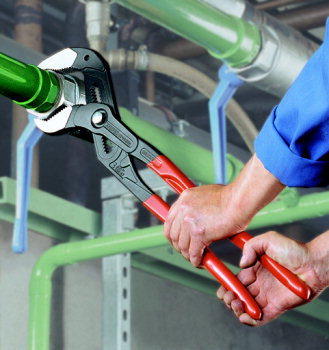
But
anyhow, the garage owner and repairman would wrench everything back
together with his silver pipe wrench day in day out and be known to all
the locals as the king of the water pump pliers.
Until some day
somebody came along showing pity on the man, and donated a socket
wrenches, so that no more after a service at this garage all other
garages would have to turn the car down because all its bolt and nut
endings would be rotten...
Thinking about the (now at least working) page on constructing a bwise graph from a
formula,
I though about when I learned about such things, which was fasionable
at the time at the network theory section (Delft University o t., EE),
lets say about 1986, in time of the rise of the big minis,
workstations, and networks. The unwritten rule at the time amoung
students and PhD students was to first be expert enough on Unix and C
before anything, and one would have to be not affraid of Lex/Yacc,
large hierarchical databases and their interfacing, complicated
simulation tools, etc.
To make a language, and not write for
instance a syntax/grammar definition first would be equally condemnable
as sinning against the rule of not making a correct nested flow
(nasi/schneider) diagram of your algoritm(s) first. Mind you the latter
is freshman informaticists stuff of course, the former hard core
Electrical Engineering matter.
This morning I woke up thinking
about what in holland was called the 'fabeltjeskrant' (the newpaper of
fables) which was an incredibly popular program in the beginnings of
the 70's [1], where they had
two beavers, Ed and Willem, who were mechanics.

A song was a big hit at the time 'Daar heb je Willem met the
waterpomptang' ('there's willem with the water pump pliers') : [2] .

Well, that was it, and that had
to be deleted, as can be seen on the wiki, I asked why.
Second, I was at another lecture of the dutch section of the Audio Engineering Society which is a
worldwide organisation dealing with all kinds of aspects of (high
quality) audio, including scientific conferences. they have a magazine
which has become availble for human fee levels through the internet, as
a high quality .PDF file. I was at lecture 164 "Bandbreedte extensie"
at Philips Natlab Eindhoven, which was fun, it had been a long time ago
I'd been there. Also I saw (half of..) lecture 166 "aes-nl mini
conference" where I was challenged to dig back in my electronicists
university past (as student assistent) about opamps and their
properties for audio signal amplification.
Reading Le Monde
A well known french newspaper, I read in a library at times, where it
at the moment arrives say a day or two late, but it varies.


Just as I've been communicating with a german synthesizer software
company from Berlin, I saw this reprint from the day the wall fell in
'89 ( I in fact was at the pink floyd concert at the time):
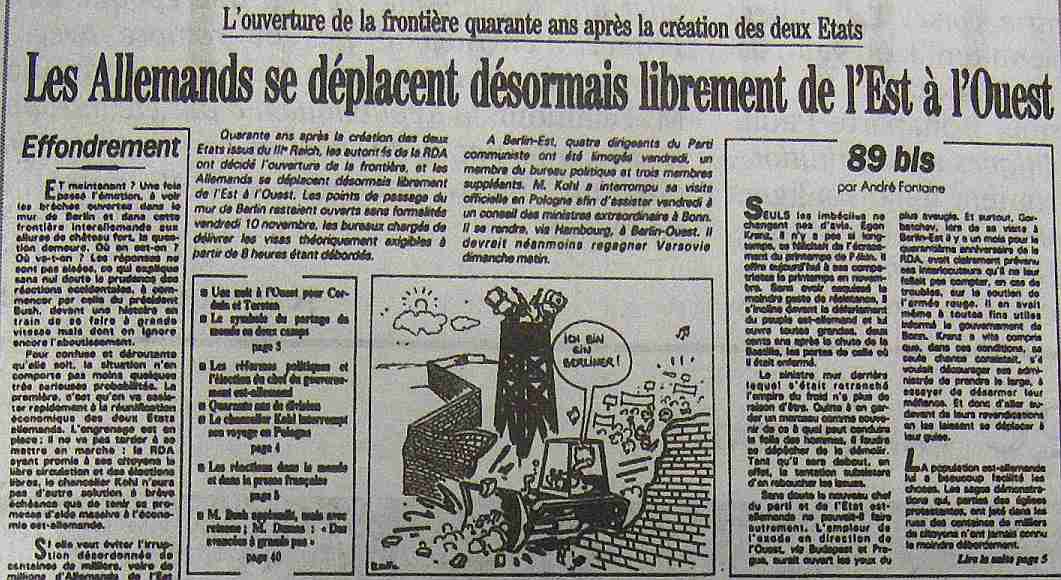
'Ich bin ein berliner !'

Some attention again for supercomputers, for militairy purposes. They
make great gaming machines, too...
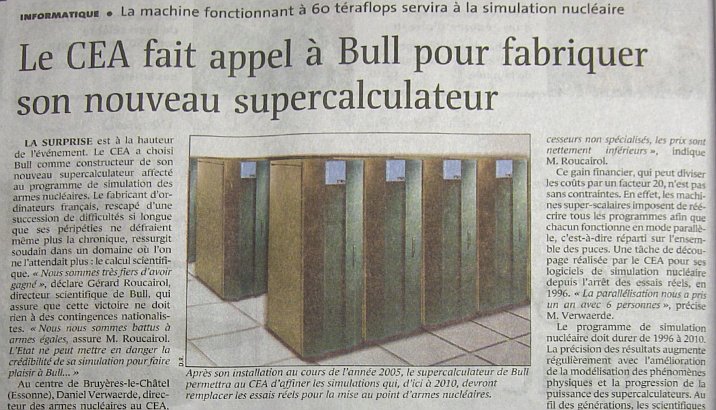
Note it appearently is supercalculateur, as opposed to giga-ordinateur
or something.
A good artice in the august 19 issue about Bob Moog, one of the most
well known synthesizer designer innovators of hisoty, who's back in
business with a version of machineries I also had ideas about some
years ago, and still have: a monophonic (only one key will sound at a
time) synthesizer, after a well known world wide still in use good
sounding hit-synthesizer (I:m sure you've heard it many times from
commericals to dance hits) but this new version is programmable, under
voltage control.
 (click on the image to download a big, readable photo, about 250kB)
(click on the image to download a big, readable photo, about 250kB)
The new company, MoogMusic
has its name back after strange ongoings the last decades, by hey, my
life too, has been quite strange in ways, probably we have to thank
certain 'übermenschen' for that... The new old synth is
still pretty expensive, considering most big synthesizers have more
like 32 or 64 voices against just one,
but the sound quality and palette is very rich and strong, and I'm very
sure for years already that in principle the complete absence of sampling puts this synth almost on
its own in this time.
The old minimoog, from early 70's or so, can still be found and bought
for about the same price as at the time, which is almost incredible in
this time of computer progress! Other good analog and microprocessor
controlled polyphonic analog signal path synths (like the oberheim,
prophet 5, jupiter 8) also are still in demand, simply because they
sound good.
It is a new fashion to play with the same big and expensive modular
synths, for which new ones have been made the last half a decade, but
which from what I have heard are fun, but not really beating their
ancient ancestors, except probably in price. Mr. Moog claims the new
voyager has preserved the good sound even though it is programmable,
but I'm not sure that is really 100% completely true from the tone of
the statements.
A prize winning movie has been
made about Bob Moog and his synthesizers, though not in any theaters in
the european west continent, hopefully a DVD is brought out soon.
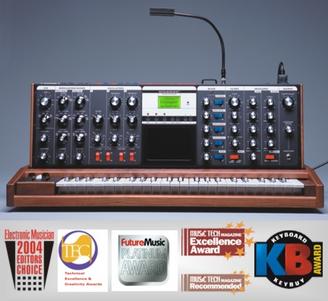
The voyager analog Moog synthesizer with
complete programmability
The synthesizer above is supposed not to suffer from any digital artifacts which so
plague contemporary music, and it has a complete analog, non-digitized
signal path. It is supposed to sound like the original mini-moog.
There's also software supposing to emulate the large modular Moog
synthesizers of old, which I've tried, and that sounds strong and
interesting on a good hifi system, but it is not the real thing, no
sir, it isn't. I've tried my electronic moog filter after the high
quality DA converter producing sounds from that software, and THEN it
suddenly starts to sound analog and not of this digital world anymore...
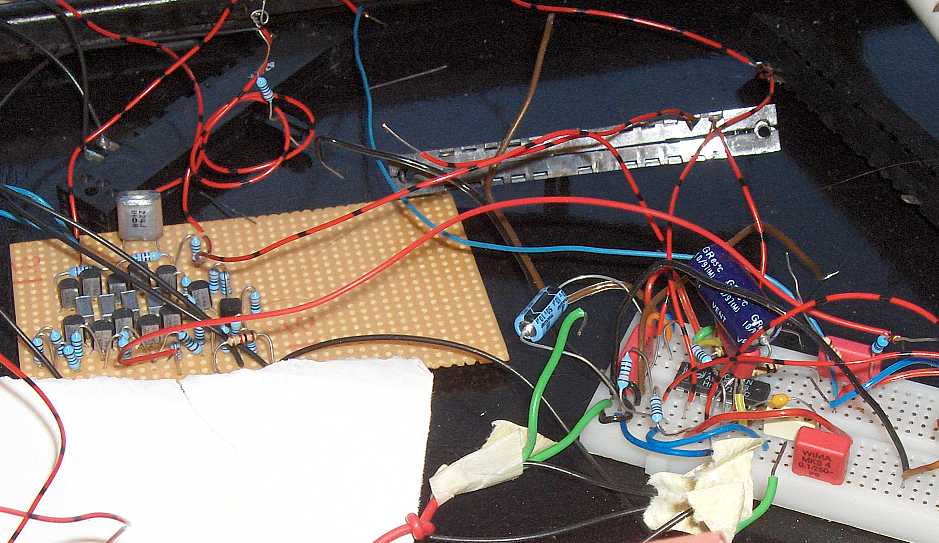
On the left, a Voltage
controlled analog 4th order filter (24dB/Oct) low pass filter
à la Moog, followed by an instrumentation amplifier.
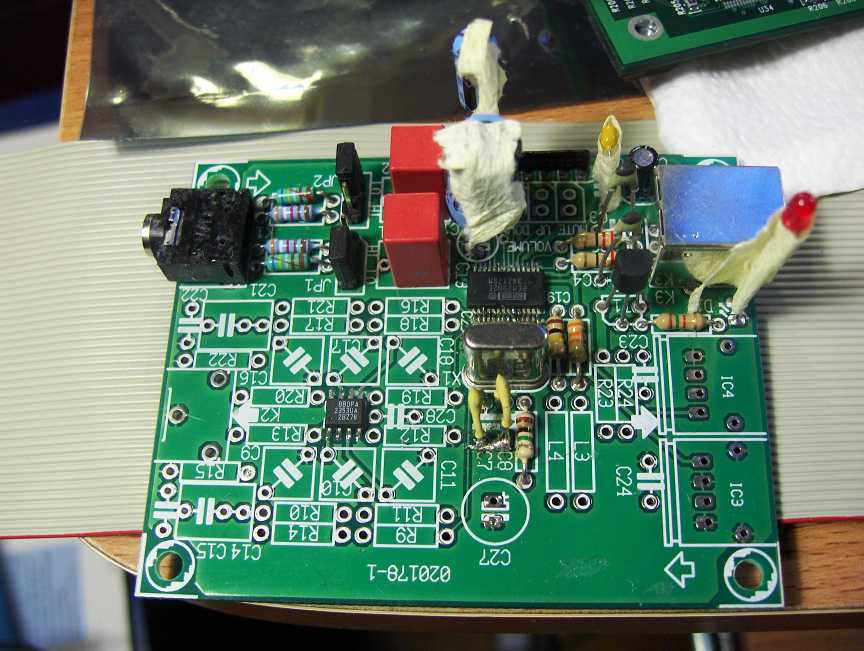
A more official
implementation of the high quality USB AD/DA converter in buildup
In the same library where they have recent Le Mondes, there is also a
musical science section, with some decent book on semi-modern
instruments like synthesizers from the 80's:

and also computer music of course.
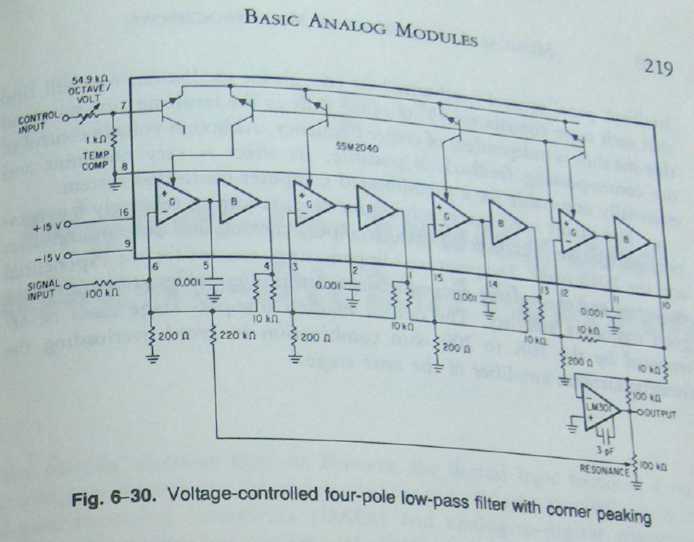
From the upper right book above, a filter circuit.
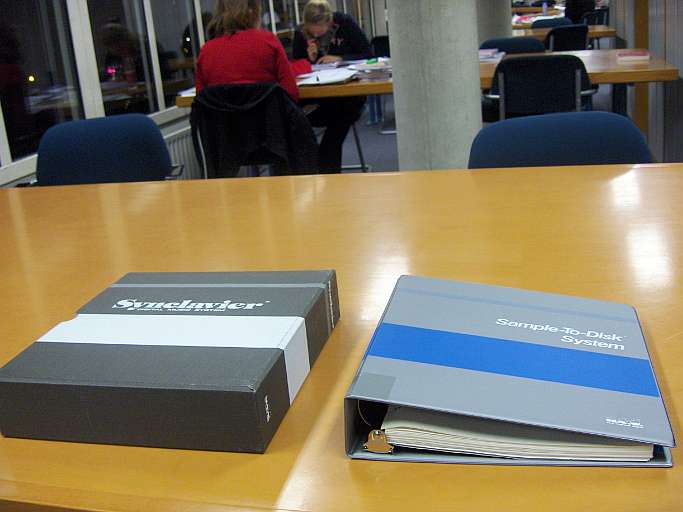
Also, the manuals of a well known early digital synthesizer: the
Synclavier, already present in 1975, with various incarnations later
on, one being known for instance for its use by frank Zappa. Many big
studio record projects used this machine in the 80's, or the main
alternative: the fairlight CMI. Both bulky, interesting, advanced for
the time, and *really* expensive. Could buy you a good new car, easily.
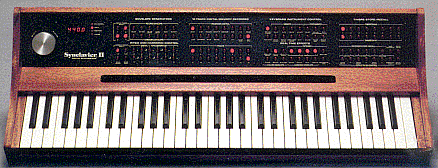
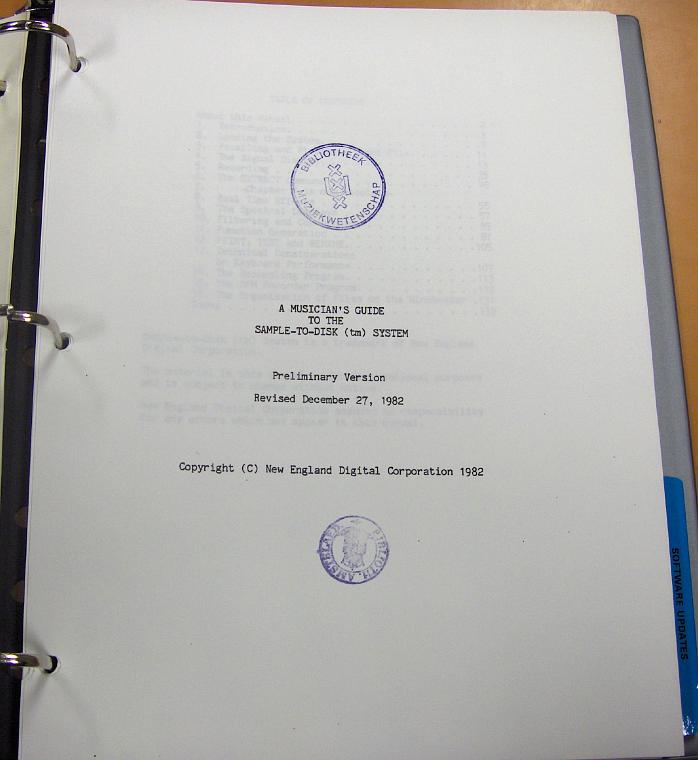
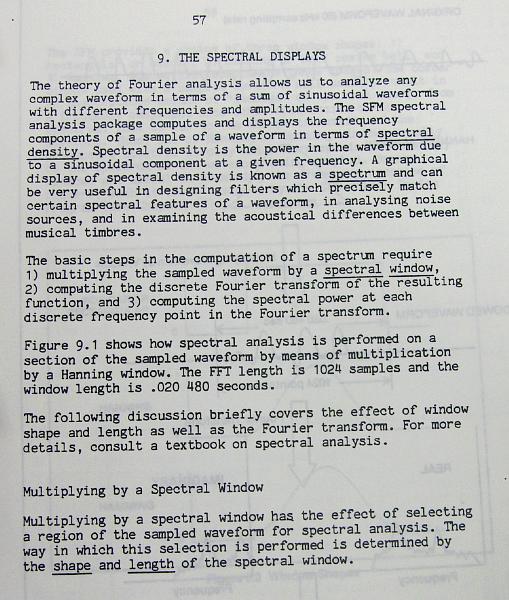
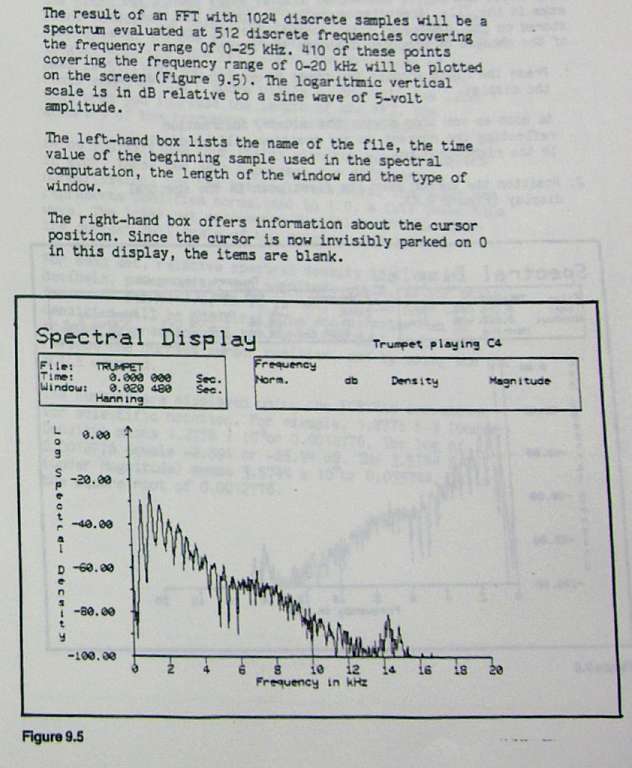
Clear to any musician from the field , and any well-trained or edified
technician from the field, the advancement in the last decades of music
making with respect to the equipment come mainly from the advancement
of electroincs, both analog and digital and their application, and
their cost effective production.
The below book (from the same library) is a bad example of what
university chaps with no technical background knowledge as it seems can
all come up with around a pretty well defined world over the last
decades (I was active part of it, I should know), when they don't
observe sufficiently that technical advancement is one of the main
reasons behind all kinds of musical equipment development. Failing to
understand that leads to many vague, socio-tainted reasonings which
make little sense, and paint a very obscure picture, while the whole
of 'new' musical instrument development is definately worth
floowing for it's content.
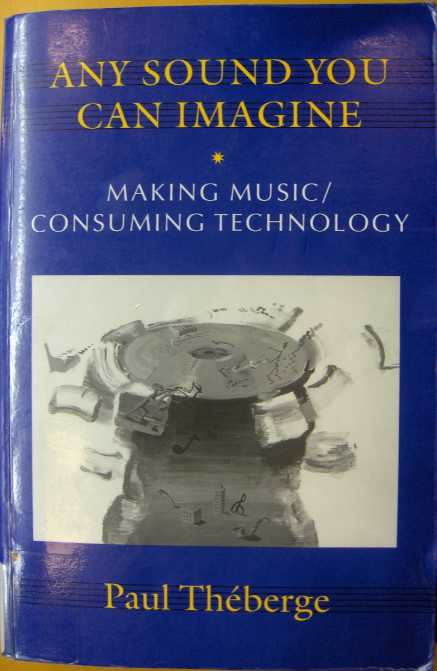
What's that picture, a disc on a vacuum clearner motor like I was told
stories about when I was little ? That's nazi talk, isn't it? What a
rubbish, though the subject is interesting. And maybe when one tries to
imagine a future where technical limitations donr't hold anymore and
anyone can have the most perfect and advanced musical instrument they
want for free with a package of milk the considerations hold, but then
again: instead of pretending to be a DJ, learn to play an instrument,
buy an electronic organ or an electrical guitar and try to make it
work. Jeez, what has the world come to.
Musical instruments, also really advanced computerized modern ones, are
*quite* far from perfect. Really, believe me.
Try out a hammond organ simulation on you PC, and next play a Jimmy
Smith record on your hifi system . See what I mean?
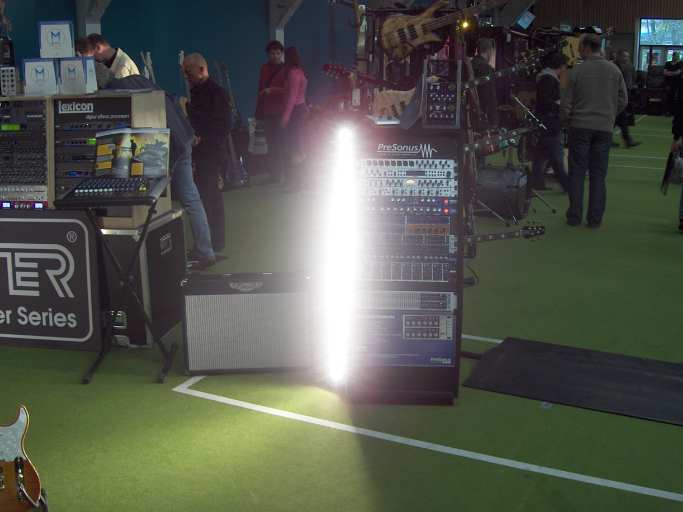
At the above fair I tried out a
guitar amplifer and effect software simulation program which was fun.
Using a S90 effect unit for the same is a lot more fu in high quality
sense, but then again the box did even some Hendrix sounds with
conviction.
Alternatively, I spent a day and a half at the French (Paris) Ircam
institute
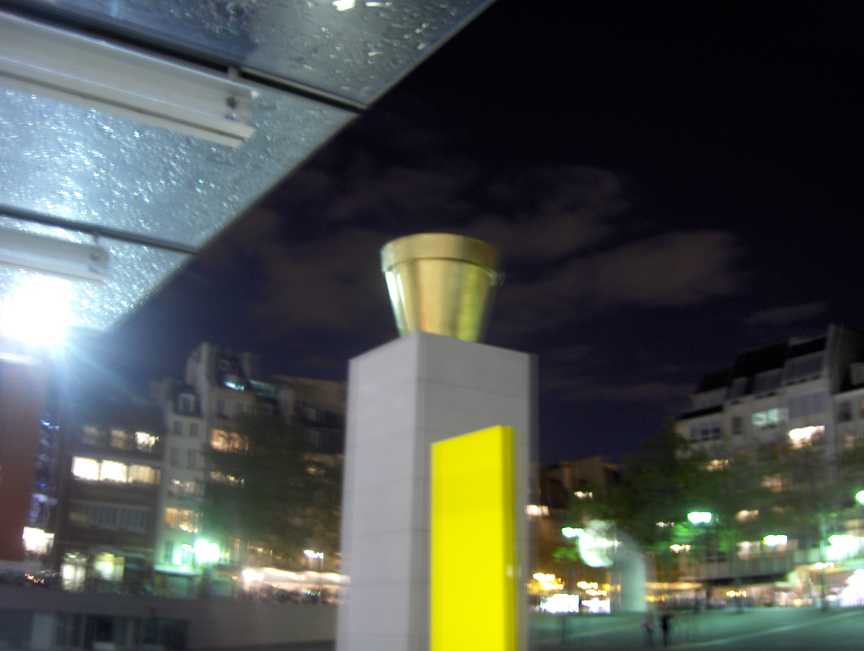
at their 'Porte Ouverte' (open days), which was interesting, though
didn't move my own work out of relevance. Of course I saw and hear a
lot of things, and it was quite pleasant to be in Paris, as far a
europe goes, that is quite enjoyable.
I guass peaks of attention were a multi channel performance (which
showed to me the sounds system really wasn't that good) a sound pannel
demonstration (wrapped in army cloaking colors), and of course to my
interest (but I didn't get around to talk much): physically modeled
instruments and sound simulation.
Dec 15 2004
Resizable web pages
 Flowers I shot in an
Amsterdam park some time ago, I think is was rainy and I used fill-in
flash.
Flowers I shot in an
Amsterdam park some time ago, I think is was rainy and I used fill-in
flash.
It's starting to annoy people, well honestly, it anoys me: all those prefab web pages with
their so called slick, but by now outdated flashiness, hopelessly
fitted to a certain monitor and a certain browser....
My pages from the beginning have been fairly limited complexity html
pages, though I've made framed pages, and used all kinds of efects, and
even made japa applets under control of javescript menus and entries,
too, but mainly I don't dislike simple html pages, headings, some
formatting maybe, no ccs, no complicated loading schemes, just tecxt
with pictures, preferably progressively coded pictures so they first
load in coarse resolution, that's fun enough and doesn't grow to get on
peoples nerves...
An issue with this is the same as it was in Desktop Publishing Software
I used already on the Atari ST almost a decade before windows 95: the
resolution of the screen. At the time I had a nice 640x400 atari
paperwhite monitor, which I had adjusted myself to have exactly fitting
and linear screen layout,. That did of course make the fonts all
bigger, and the dots in drawings, too. Nowadays, I regulalry use a big
19" monitor with 1600x1200 pixels and therefore smaller pitch than most
common monitors, so natirally, everything on the screen looks smaller
than 'normal'.
So I am in the habit of viewing web pages with Netscape (7.1 or so) set
to 120 or 150% enlarged fonts. This has the major advantage of seeing
text with a higher resolution, that is with finer pixels, and works
fine for 'normal' web pages, except for pictures, which remain a but
smaller, but that's ok.
On preformateed pages, and pages with menus and such, scaling page size
up is desastrous: menu enries don't fit in thier box, sliders don't
work, parts of frames aren't visible: not good.
But then again, when working on windows (linux is a bit better in that
respect) lets say XP, enlarging the system font is also not without
difficulty: various facilities recognize that the system font must
indeed by larger, which is better for readability (effectively a higher
resolution, especially when sitting a bit at a distance of the screen
and enlarging 150-200%) , but not all, and it doesn't really work well.
For instace certain help files remain at the smallest font type, which
is annoying to work with. Though the screen handles small resolution
well, so the texts remain readable, and of course a lot fits on the
screen. It appears the latest Mac OS products deal with scaling better.
Pictures are another story, I love to have reasonable/good quality
pictures in even quite high resolution visible on the 1600x1200 screen,
which is about 3 times more detailed than current average screens, that
look pretty good. In principle, one might want to have varying image
sized on web pages, too, depending on download speed and screen
resolution, probably that can be good for the appearance of web sites,
and worth some effort to make.
I don't mean that one simply scales up images with text, because that
would become 'dotty' or grained, but receiving a web page which
contains the right image resolution and sized for a certain screen
situation.
Anyhow, all those macromedia things, and all kinds of prefab made web
pages score very low on scalability, which is not good, even tough that
would be possible.
Moral, decency and condemnation
In Holland of course it is still a pile of miserable fascist junk at
best.
 The
dutch minister president in a cartoonish pamphlet indicating with the
kind of electrical machinery high voltage sticker that 'holland
deserves better'....
The
dutch minister president in a cartoonish pamphlet indicating with the
kind of electrical machinery high voltage sticker that 'holland
deserves better'....
Maybe people in fascism are even more senstive to wanting all the
miserable deformations of life actively:
 Art in the lobby of the new the Hague city
hall building
Art in the lobby of the new the Hague city
hall building
There was a tv program on "
the
value-whisperer of the Dutch minister president " on
VPRO protestant television recently, which was not just not flattering,
but downright horrible.
In the same horror category this lecture anouncement from delta , the Delft University
newspaper has the nerve to suggest actual moral could come from the
professor that kicked me out shamelessly after an incredible amount of
sh*:
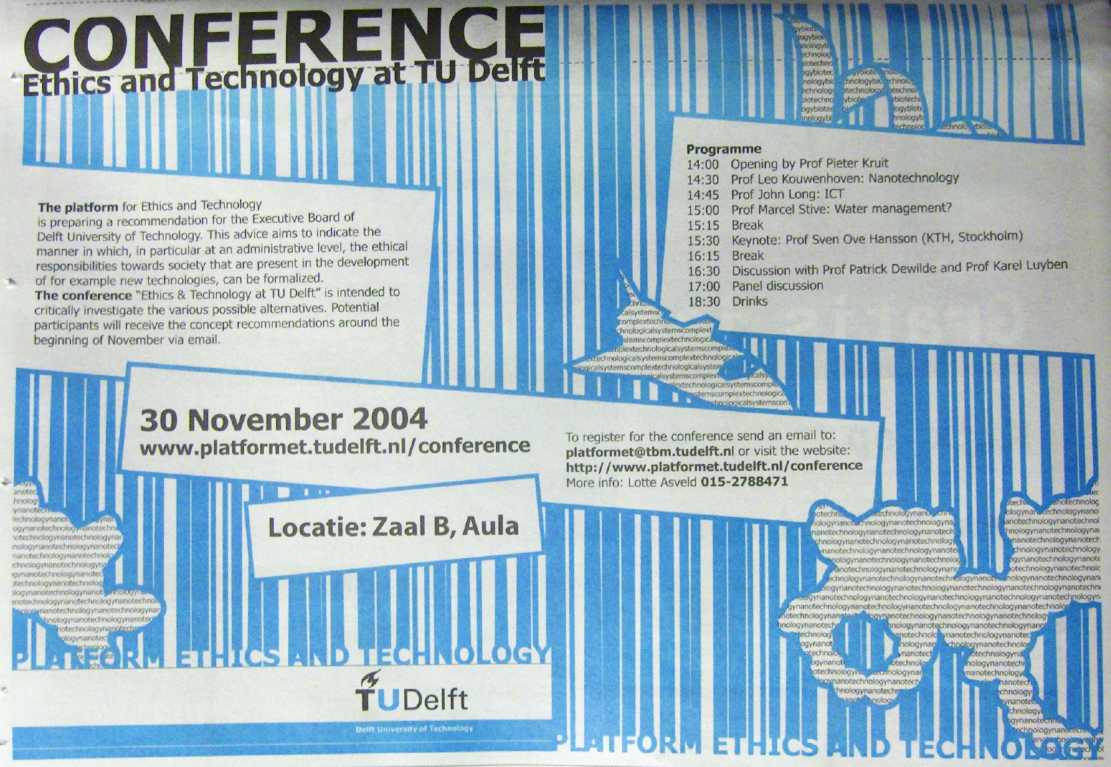
Shameless. Brutal. Calls for war, or the pope.
Platonic Music ?
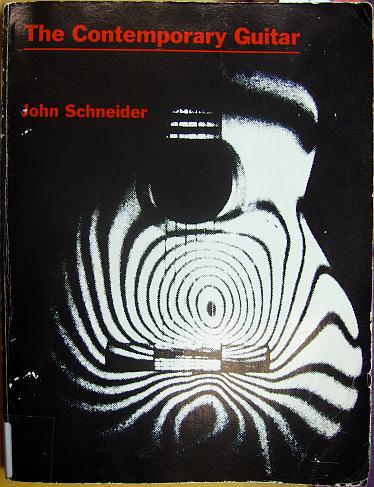
To the agony I'm sure of some people my self-built speakers and
amplifier (and USB DA converter) have been tested in the Cultural
Centre (formerly the Muzisch Centrum) of Delft University, along with
some lets say techno-like DJ persons. For sure those guys no little
about decent (not sucking) PA amplification or HiFi (disco-) mixing...
And I'm sure they were sort of taken aback by what a powerfull amp with
strong speakers can do to high quality sounds with accurate and fast
and controleld transients instead of bass-port resonsance driving bass
lines, ending up all sounding the same.
So, I let them have the volume knob reversed, as in I though I wouldn't
just leave then to it. After all, my high-mid frequency range squakers
are only 25 watts officially, and I'm sure my woofers will reproduce a
300 watt square wave per stereo channel, too, just like the bass-reflex
monitor speakers they used alternatively, but wether my (also 12 inch)
woofers would antually like or appreciate that... I don't think so, and
they are not necessarily easy to replace, so I though I wouldn't take
the risk!
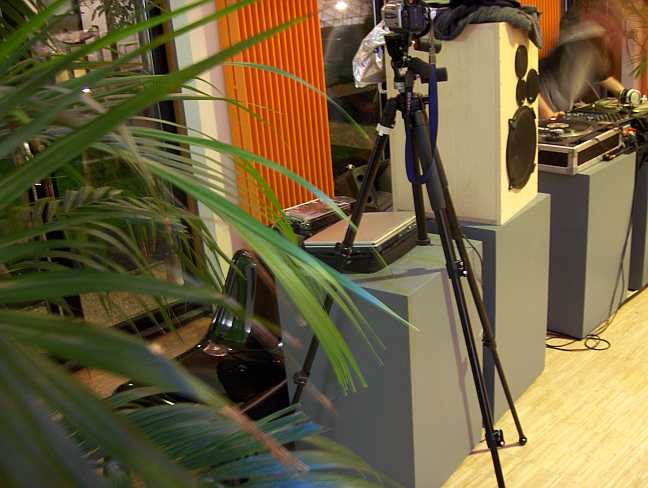
The hifi experience was already more than overpowering enough, I heard,
even when the house style music I amplified along got no more than
maybe 1/4 of the power of my system. Those vinil records should sound
pretty
OK by their lack of DA conversion, but I don't think the quality of the
turntable and the element, or the records after scratching are up to
reasonable quality standards, and as everyone should know: play a
arecord more then 10 times, and the quality of the high frequencies
has already worn out a bit.
Anyhow, I liked acoustical sounds already decades ago when I apart from
electronic keyboards and digital synthesizers I also learned to play
the acountical guitar (country and western style guitar). The image
above reminds me of a graphics model I made somewhere before '90 when
making a 3 dimensional model of a guitar body, except the above image
seems to show the standing waves or strain patterns on the blade, which
is interesting. Why does a guitar sound good? Anyhow, lets say the
below idea sound a lot better to me than some more afro americans with
a big belly blah-ing about how much rubbish they can actually produce,
or guys getting of actually scatching records. Please, can't they leanr
to play an instrument? There are excellent courses for that.
Why are those record companies not out of business yet? Haven't we
heard enough of hip/hop and U2 non-sense, or does the world not deserve
better? One would be tempted to secretly hope that Napster (for mpegs
only) would win. And let there be some well produced super CD's !
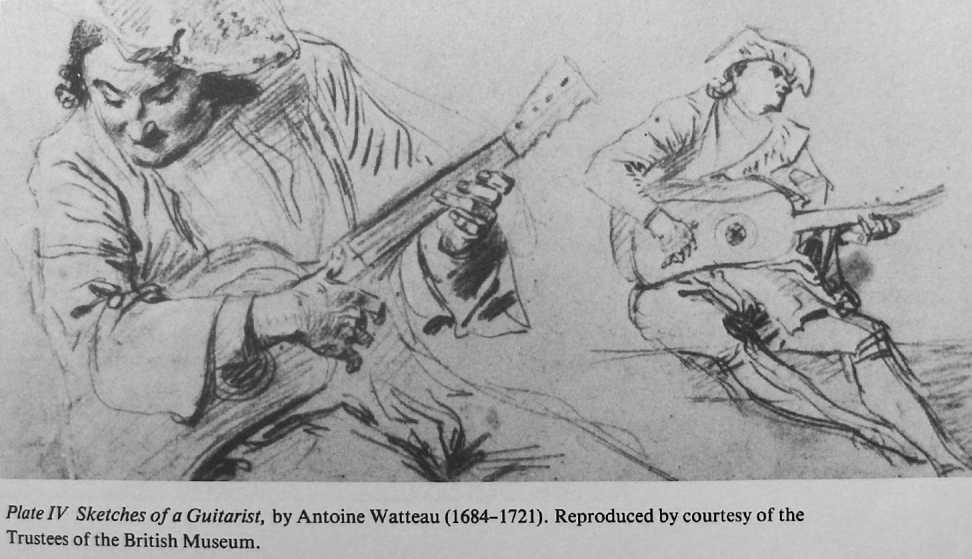
Very early acoustical guitars, the image seems to radiate a good
atmosphere. They'd have had to wait 2 centuries before Robert Johnson.
Probably 'Owl-pop' describes the current state of affairs in 'popular'
music, when one is in a good mood:
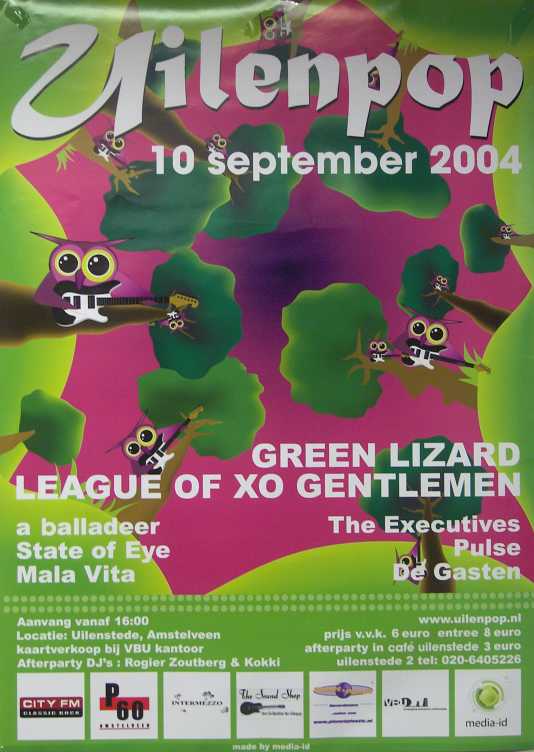
See you later, Owls!
What's up and what's going down in the wonderfull world of
electronics ?
Well, I hear mostly normally a lot of things go up. I was official
electronicist at Delft university for years, as practicum assistent,
and I was good at that. And of course electronics was one of my big
hobbies in highschool, and I most certainly was very good and advanced
at that. Electronics interestedme already i primary school,. and I gues
I feel naturally enough there.

I became invited to a 'Silica' (or AVnet) meeting for certain reasons
recently, to a seminar about various dutch electronics (often
digital/computers) branches, and for a christmas dinner and a workshop
on a new Analog Devices microcontroller with Arm processor and decent
IDE, where a small pcb with the processor and some perifierals could be
taken home, so I now can handily use it. Cool.
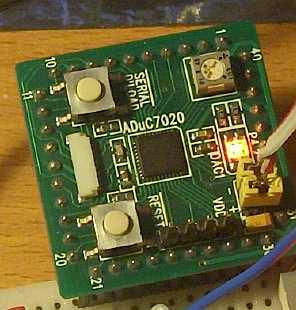 The 7020 based little stamp
board with quite powerfull 16 bits risc ARM and multiple 12 bit AD and
DA's..
The 7020 based little stamp
board with quite powerfull 16 bits risc ARM and multiple 12 bit AD and
DA's..
Electronics break, too, like I'm sure can be caused by worn out
capacitors in a switched supply. A TV box I can use from Pinnacle,
which digitizes into an MPEGII stream over USBII live, had it's chinese
supply broken recenty. It's supposed to feed the box with 6V 2 amps,
but it's dead now, so I improvised a replacement, which is not too
easy, because 2 Amps is more than most standard solutions can handle.
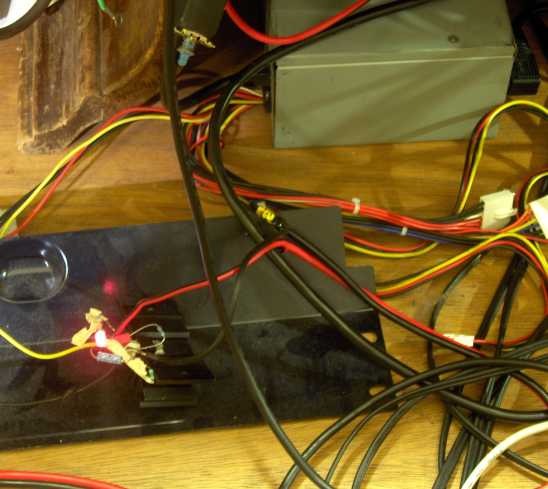
I used a found (with the garbage) old computer supply unit (the box at
the back) and a lm337 regulator chip on a heatsink and some parts to
make a nice 6 Volts supply from the 12V output of the computer unit,
which is then fed over 2.5^2 wires (the thick red/black ones) to the tv
box: andit runs fine.
I'm making pages about the blackfin
DSP EZLITE boards and Xilinx
interface to that, which is working already. Now to connect many
parts up to the setup I prepared a lot of connection wires (over 150
connections) for displays, buttons, knobs (I used one of those eternal
dials) and AD and DA connectors, and maybe external static memory.
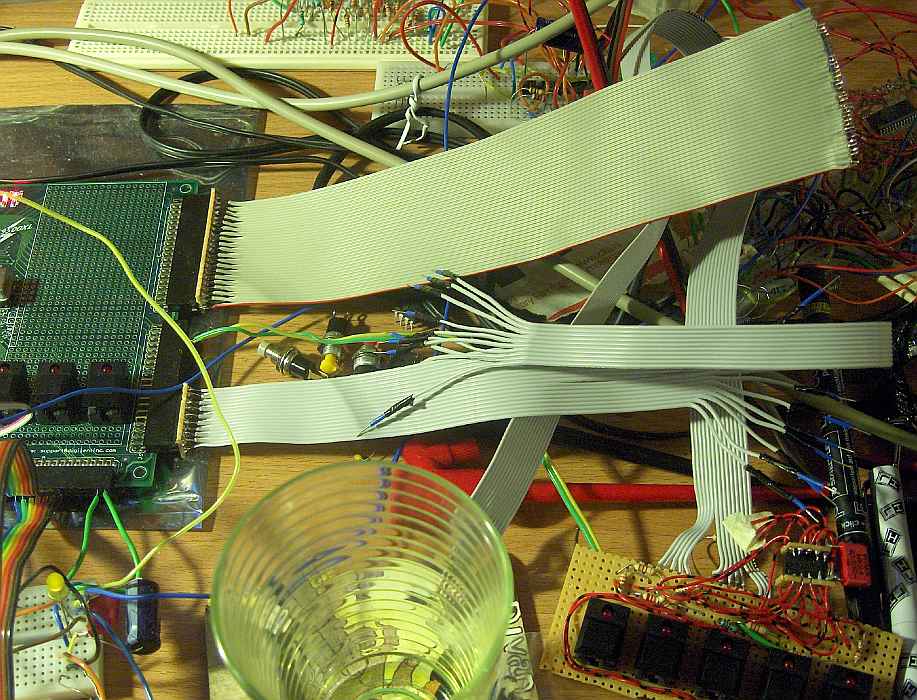
A good place for electronics is an earoplane, in this case: a
completely electrical one:
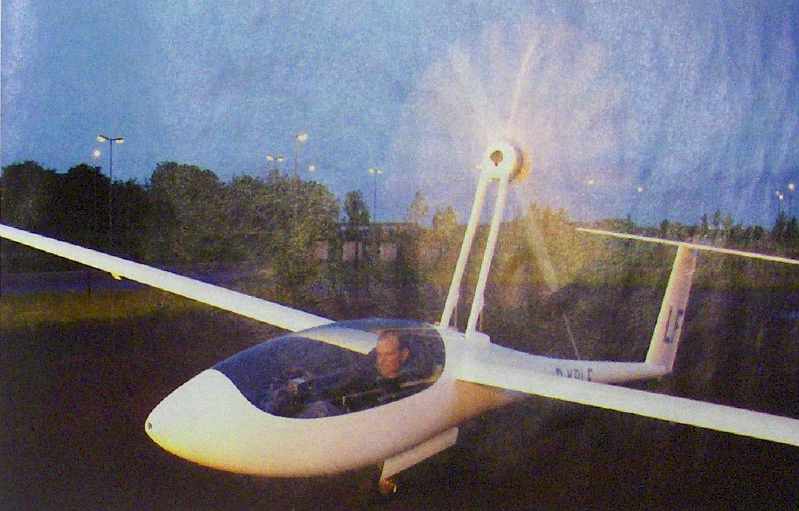
Flying by batteries!
Now a little field with nice blue solar pannels, and we dont't need to
worry flying in the nicest green environments as much as one likes.
Alchemy
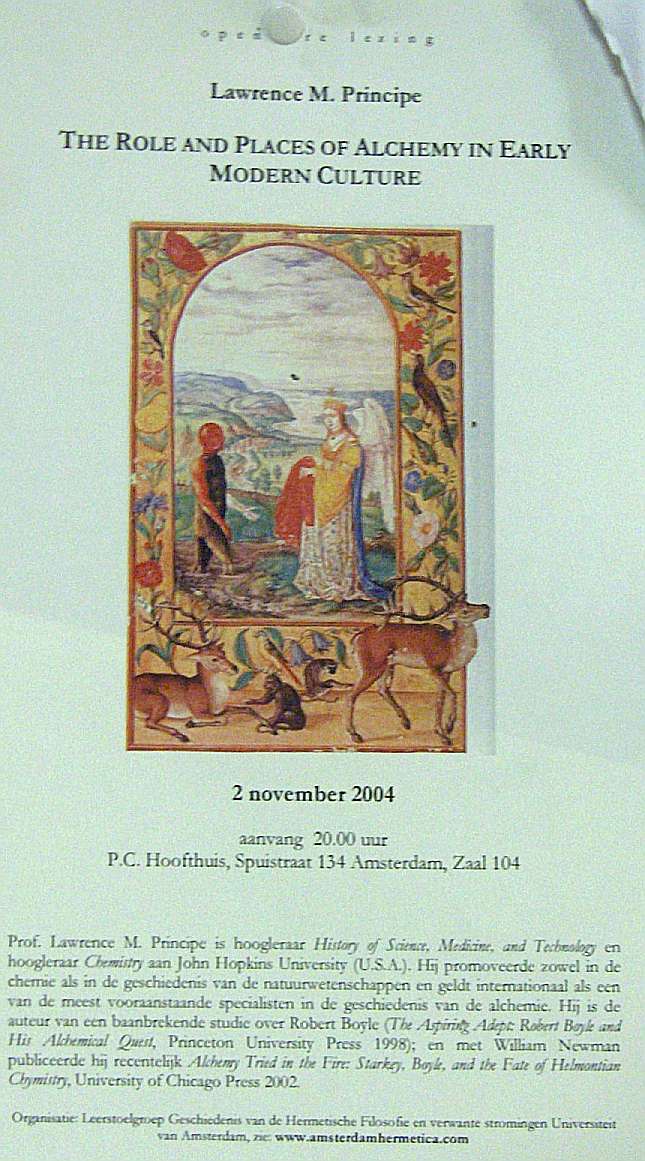
I visited a lecture from Lawrence M.
Principe about "The Role and
Placed of Alchemy in Early Modern Culture" at a language
building of Amsterdam University (where as all should know I've never
been a student or scored any grade, I've often been working there on my
own subjects though, also in some miserable times). Organized by the
section of history and
hermetical philosophy, the as it appeared prominent speaker from
Hopkins university (US) made clear alchemy, lets say trying to make
gold by chemical processes which could be mastered in the middle ages,
was an important idea having to do with getting away from the main
modes of life which lead to the organisation and (mind) control of
people in unpleaseant or undesirable ways.
Lets say somebody at microsoft is hacking Linux in his spare time , is
that alchemy? No I guess not, but the idea of people wanting power over
matter and wanting to do something unique and unknown, which has great
value too is the idea.
I'm sure the tenure was that modern people also have all kinds of
alchemistic tendiencies which may rule a great deal of life, without
anybody daring or willing to break through the taboos around such ideas.
It is my distinct impression that a lot of people would like to turn
their computers into gold by using just the right kind of ingredients
when they put programs on it and use all kinds of things computier
users use.
More like a religeous quest for some holy grail then techinically
oriented activities, and therefore dangerously jeopardizing sanity of
mind and thoughts. Sourcerers looking for idols to worship.

I'd rather go back a bit further, for instance the old french town of
Tour (of Gregory of ~) or other nice landscapes, and enjoy the view:

I've been able to have a picture like the above printed on 20x30 photo
paper which looks quite cool, that format is just fine for 5
megapixels. The below is an experiment with very long shutter times,
with nice spooky result:

Even in these not retarded nice resorts in green nature, another spooky
effect needs to be discerned:

pictured along the wonderfull river shore line in Tours.
Electronics Parts Samples
Now that's a different story. Suppose you're electronicist with an
interest in the latest development in electronics, then what can you
do? GO to a a specialty store? Visit a collectors meeting? Well,
probably since about 92 (?) when I started doing that as part of my
profession, one would browse the web. And ask some of the semiconductor
suppliers/manufacturers for samples
of products you're interested in, if and when you're also a practicing
electronicist, an experimenter, or even prototype builder.
I was those things already at 12 or so, and my projects I made myself,
and they worked, too, I guess one could say I was a miracle child,
though I never though about that myself. So when I'm doing now at times
is not really (thus far) challenging my knowledge or skills much.
But, to get some things in gear a bit I thought the last years I'd keep
up with electronics developments, and also get a decent set of samples
or otherwise gotten parts to work with.
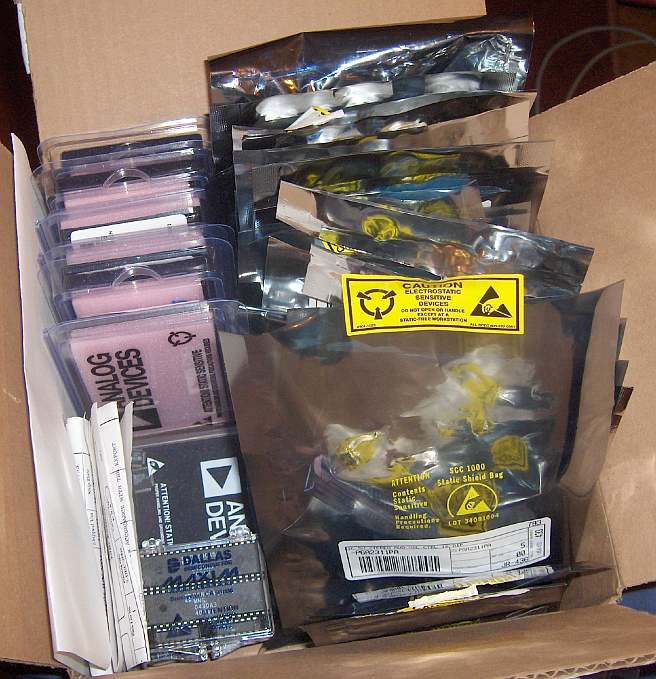
The box with my current
set of samples, all in antistatic bags.
That has led to a good set of parts which I'm sure will prove usefull
in various prototyping, research and development projects I'm
doing.obviously in the fields of audio and sound
synthesis, but also more general projects. I guess the total value is
easily $500 or so, but then again: I se them for the actual reason
they're given out for: prototyping. It's nice to have access to recent
'hot' electronics parts, and most of them come not so slow via a parcel
service with tracking facility, so you can follow the package from its
source until it is delivered over the internet.
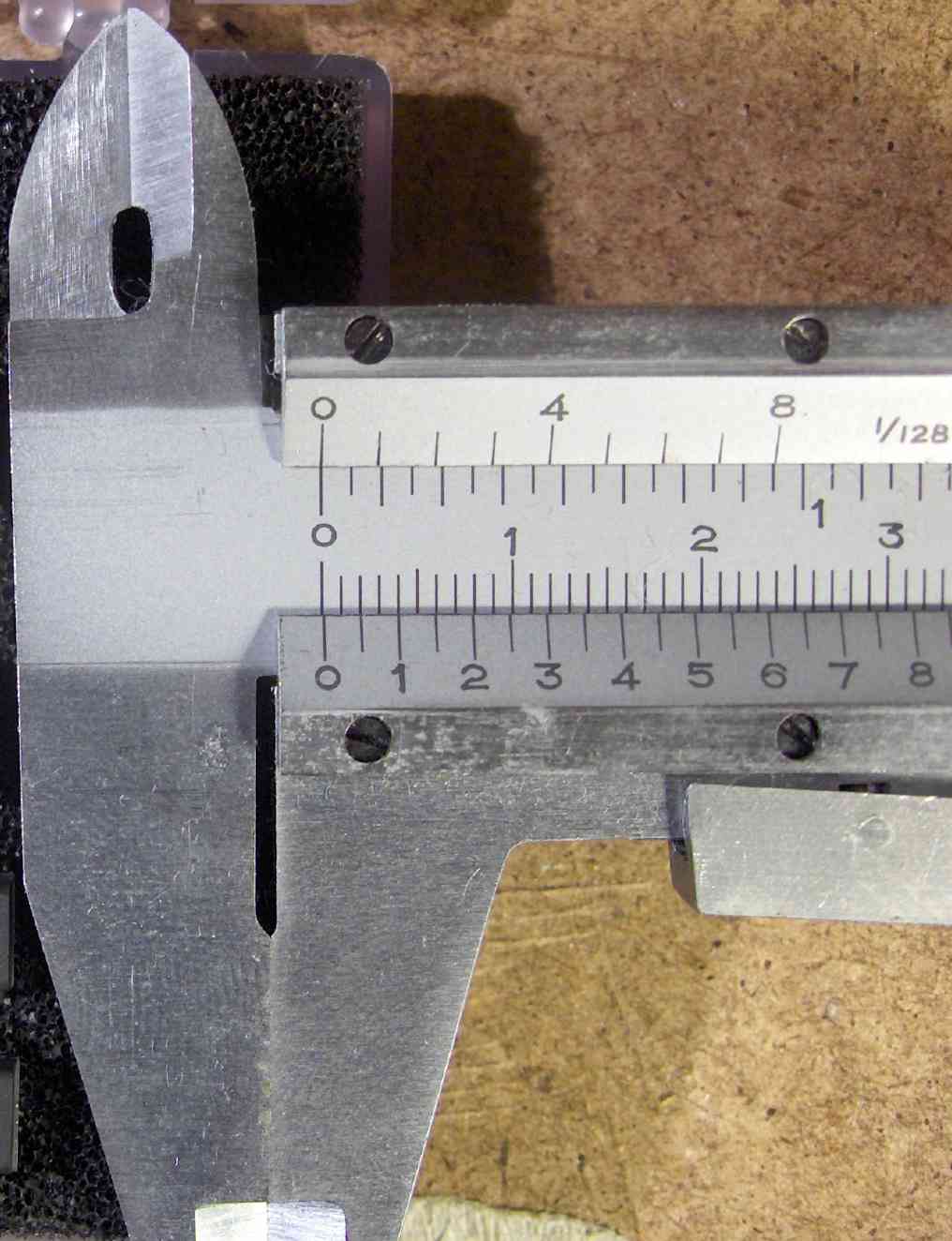
Most of the below
images in the sample chip list are to scale of the
above ruler!
Below is a summary of the sample parts that I actually received, with
pointers to the web pages of the chip manufacturers offering them, and
pointers to the (pdf format) datasheet of each one of them. the number
is the number of parts I received (asked for). I made the pictures of
the actual parts, and after the picture and short description follows
some reasoning about what I want with the particular part, and when
I've used it already my experience with it.
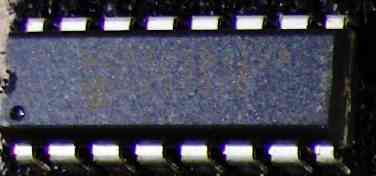
MCP6S28-I/P
: 1 , Datasheet
Programmable Gain Amplifiers offer 1, 2, 6 or 8 input channels
respectively and eight steps of gain, programmable over an SPI bus.
I got the 8 channel part in DIP (Dual In Package) form, which can
easily be used in a breadboard. The idea is to use it as front end for
AD converters of not super hifi quality, for instance to measure
potentiometer or temperature sensors, so that the programmable gain is
handy.
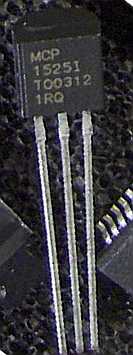
MCP1525-I/TO
: 2 , Datasheet
low power, high precision voltage reference, 2.5V
I tried this one out with a digital multimeter and they agreed easily
withinn tolerance, though not perfectly. Funny enough it needed a
capacitor to filter the output voltage, or else the meter would go
bezerk.

PIC18LF4539-I/P
: 2 , Datasheet
PIC microcontroller, flash memory
A relavtively big and heavy PIC which needs a clock (I can give it
that), and a serial programmer (I'm working on that), and of course a
programmer or lets say at least an assembler which produces a hex file.
I downloaded MLAB which needs a programmer, but probably can give me
the right hex file. Also I downloaded and installed working the
sourceforge SDCC environment under cygwin, which should be able to
produce PIC80 compatible code from C source, but I need first to see
how I can make a programmer.
The rest should be easy, its a DIL, there are examples, and well, a
microcontroller is a microprocessor system, I know about those.
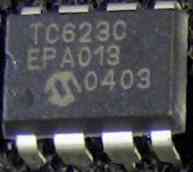
TC623CEPA
: 3 , Datasheet
3V solid-state, programmable temperature sensor
In fact this part has only digital outputs, its for driving a fan.or
alerting at high temperature, primarily. It has hysteresis at its
'fan-drive' output. Unfortunatel, I can't use it for the amplifier
chips I use, because they auto-retaliate at 150 degrees Celcius, which
is too much for this case.

MCP6549-I/P
: 3 , Datasheet
Open Drain, quad comparator

DS89C450
: 2 , Datasheet
Ultra-High-Speed Flash Microcontrollers
This should be a decent, compatible microcontroller, based on the
archaically present 8051 core, but quite fast, 33 MIPS. I got this
serial download program for it, and the sdcc compiler/assembler should
be good for it, but I haven't tried it out, and I'm not sure all the
pitfulls are covered yet. The only microcontrller I did program
succesfully (except my own Z80 based experiments) already was the AD
7020 ARM based one, which is new (and not so much available yet it
seems) and quite powerfull. Except impossible to solder, I'd think. AD
uses a Keil based programming env with gnu compiler which works fine
thus far.
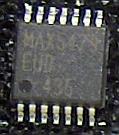
MAX5479 : 2 , Datasheet
Dual, 256-Tap, Nonvolatile, I^2C-Interface, Digital Potentiometers
For all kinds of control settings, offset control, and not-perfect hifi
volume control, didn't try it out yet. It has flash memory and some of
these chips can be reprogrammed quite meany times, so it can actually
be used as part of a machine that way, for instance for defaut setting.
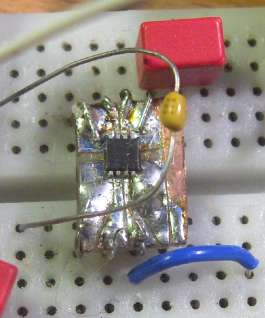
MAX7418 : 2 , Datasheet
5th-Order, Lowpass, Switched-Capacitor Filters
A filter which has a cutoff frequency depending on a digital clock
input frequency. I've tried it and it works, but I didn't really like
the sound quality when an audio signal was fed through, though I also
didn't really dislike, so it would work in a synth setup. covers the
audio range, and has reasonable clock rate distance wrt the cutof
point. The little pcb on the picture I made myself to make a breadboard
unit.
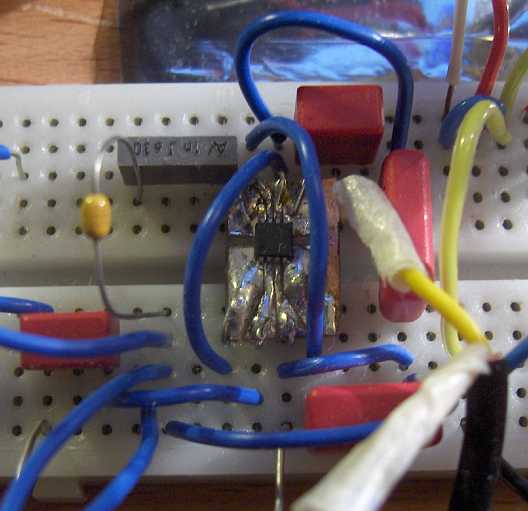
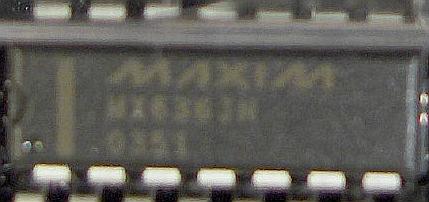
MX636 : 2 , Datasheet
True RMS-to-DC Converters
Good for synthesizer units, compressors, and maybe measurement setups.
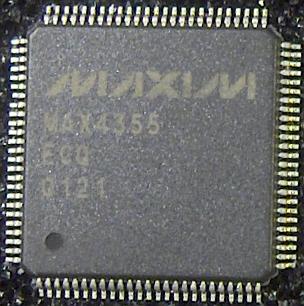
MAX4355 : 2 , Datasheet
16x16 Nonblocking Video Crosspoint Switch with I/O Buffers
I got an alternative doing the same from AD, with a bit different
programming scheme, but both feed 16 inputs to 16 outputs in any
permutations, and with little loss and not so much distortion, though
unfortunately not even at 0dB up to my hifi standards.
For video signal switching (like TV, VCR, Satelite, camera) to various
sinks: TV, vcr, PC tv cards, etc. Wouldn't require 16 channels for
that. It should be up to computer monitor signals, too, frequency-wise,
that may be good.
My primary idea was to make it part of the ananlog signal path of my
synthesizer prototypes, which then becomes routable in the analog
domain, without delay, and without having to use patch cords. It could
be used for modulation signal routing from lfo's and envelope
generators to all kinds of inputs.
There are buffers, so routing from one source to various sinks is
possible. IT's a pity the pins are so undecent to solder, but hey,
they're there to be used, and it's not impossible, I've done it before.
I just requires adaptor PCB, and yep, they are hard to get, and not
completely cheap....
The control input doesn't allow PCM up to very high supersonic rates,
IIRC.
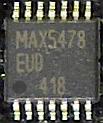
MAX5478 : 2 , Datasheet
Dual, 256-Tap, Nonvolatile, I^2C-Interface, Digital Potentiometers
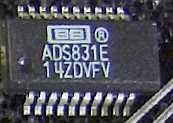
ADS831E
: 2
8-Bit, 80 MSPS ADC , Datasheet
See also my local
diary page 3.
I've tried this chip out before at low data rates and it worked but I
wasn't satisfied with the DC behaviour, though that can easily be the
result of the long wires I used for this race-car type analog to
digital convertor, which probably would prefer real short lead
decoupling capacitors. I used it sucessfully with a computer graph
readout, but later on my experiment setup got noisy, and wasn't well
behaved enough anymore when I tried to solder on little SMD capacitors
directly to the chip. Maybe I didn't pay attention to anti statics,
maybe I overheated the chip or made it gather moist, or maybe my setup
was just messed up. I have another one I may put on an adapter board,
and feed to a Xilinx and therewith to a BF533, to get some realy sporty
converter times for scope purposes.
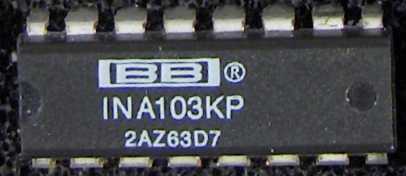
INA103KP : 1 , Datasheet
Low Noise, Low Distortion Instrumentation Amplifier
I tried it as balanced audio amp, which worked, but I wasn't really
satisfied.
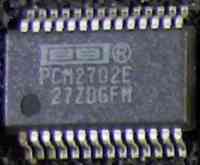
PCM2702E : 1 , Datasheet
16-Bit Stereo Digital-To-Analog Converter with USB Interface
Got replaced in my thinking by a 2906 (DA and AD) before I got to
trying it.
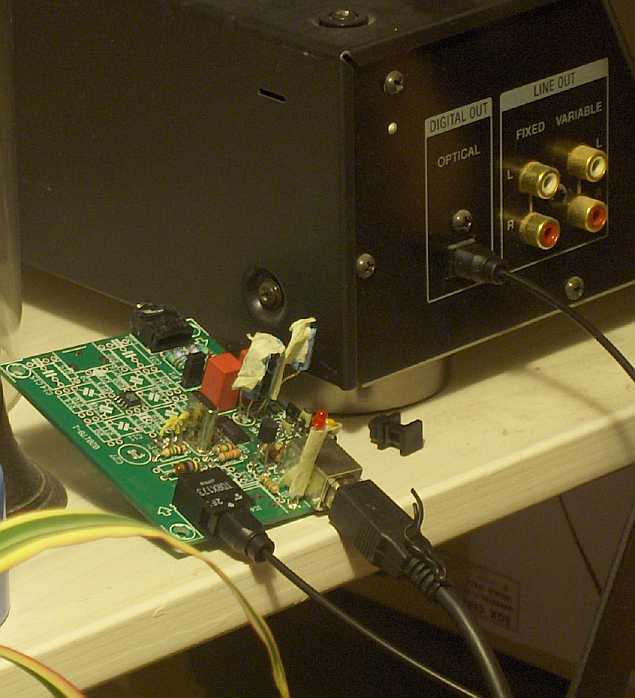
PCM2906DB : 1 , Datasheet
Stereo Audio Codec with USB Interface, Single-ended Input/Output and
SPDI/F
Very decent high quality audio (as compared to good hifi sets) DA
converter and pretty decent AD converter, with excellent measurement
results. See a previous diary page for my first, self made prototype
PCB, here shown is a prefab pcb with the 2902 (almost the same)
which I've tried before it was all finished (it still requires an
accurate external voltage reference for the AD and the filter for the
DA) in this case with an optical link. The optical link works fine with
a consumer (sony) CD player, which can be made audible over the
exisitig other DA prototype based on the 2906 by using a audio pass
program I adapted to work with more than 2 sound channels. Sounds quite
neat.
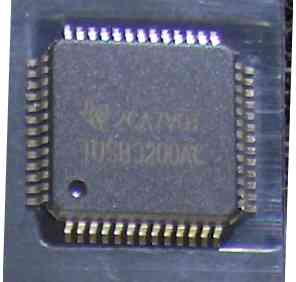
TUSB3200ACPAH : 1 , Datasheet
USB Streaming Controller
Not tried out yet because it would seem a bit cumbersome to program.I
would be good to use as multichannel, 20/24 bit high sampling frequency
(192kHz?) interface for the blackfin audio channels to a PC.
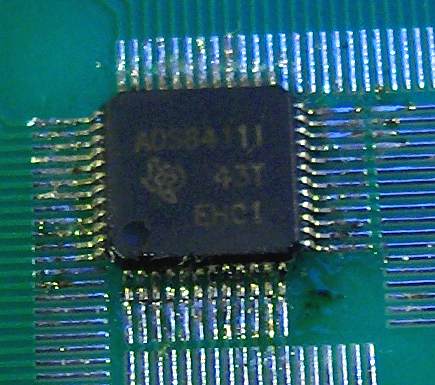
ADS8411IPFBT : 1 , Datasheet
16-Bit, 2MSPS ADC with P8/P16 Parallel Output, Internal Clock &
Internal Reference
I've started a prototyping setup with this nice little chip, again with
almost inpossible (but not quite for me) soldering pads, because I like
to try using it as a microphone AD converter at 1 or 2 megaherz, as
input to the blackfin DSP tomake sure I get rid of most high frequency
sampling a phase artifacts. I'll have to filter the output to get real
16 bit data, I think it will be effectively 14 bits noise free, which
isn't perfect, but filtering should make it ok, and then a good
reference for audio digitisation and measurements, and alternatively
for synthesizer control signals.
I first must get it to tick, though! I at the time only asked for one
sample, which isn't smart because if it breaks I have no replacement,
but IIRC it was expensieve... Well, 16 bits at 2000MS/s probably IS
expensive!
(See above on the lower left of the usb optical example board)
OPA2353UA : 3 , Datasheet
High-Speed, Single-Supply, Rail-to-Rail Op Amps MicroAmplifierTM Series
Decent audio opamp, though I haven't decided on the problem yet, and it
isn't all perfect if I remember correctly., used as 3 pole filter in
above prototype DA USB converter.
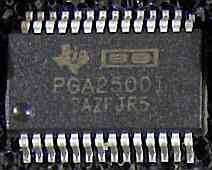
PGA2500IDB : 6 , Datasheet
PGA2500: Digitally Controlled Microphone Preamplifier
I'll work with this one a bit, which should be good for a very decent
balanced microphone preamp, which on top of that is digitally
controllable. Excellent chip, is seems, lets hope it will work in
practice.
(no image)
SN74ALVCH373DWR : 4 , Datasheet
Octal Transparent D-Type Latch with 3-State Outputs
Smd version, I tried it at 3.3V, it works, but it unfortunatily didn't
like my feed the output over a resistor to input trick to make
debounced switches all too much. Bt the datasheet warns for its bus
hold circuitry...

SN74LVC2G00DCTR : 1 , Datasheet
Dual 2-Input Positive-NAND Gate
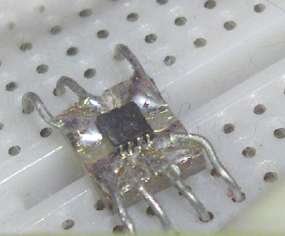
SN74LVC3G14DCTR : 4 , Datasheet
Triple Schmitt-Trigger Inverter
I tried it using this adapter, and it did fine, though I think the
frequency range wasn't soaring, but reasonable. I wonder what the wires
have to do with that, making a semi DIL of it might do the same to the
speed as a dil package, or what?
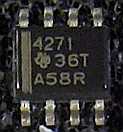
THS4271D : 1 , Datasheet
Super-Fast Ultra-Low Distortion High Speed Amplifier
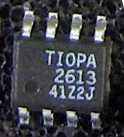
OPA2613ID : 2 , Datasheet
Dual Wideband, High-Output Current, Operational Amplifier with Current
Limit

OPA2726AIDGST : 4 , Datasheet
Dual Very Low Noise, High-Speed, 12V CMOS Operational Amplifier
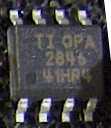
OPA2846ID : 4 , Datasheet
Dual, Wideband, Low-Noise, Voltage-Feedback Operational Amplifier
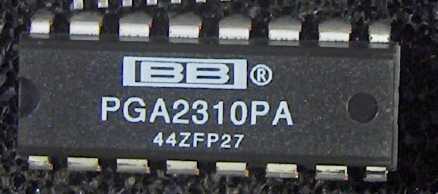
PGA2310PA : 2 , Datasheet
+/-15V Stereo Audio Volume Control
I asked TI for these A grade alternatives of the normal grade I've used
extensively in a prototpye in practice before I dive into tone
control/equalizer circuits with digital control. The result promises to
become really one of a kind excellent audio building blocks under
computer control, which is quite unique and a very strong and essential
controlled analog domain issue.
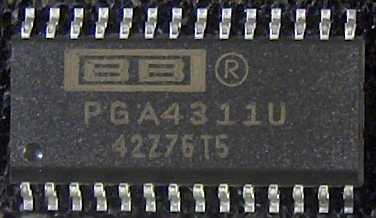
PGA4311U : 5 , Datasheet
4-Channel, +/-5V Audio Volume Control
Below a part of the prototype on breadboard is shown which contains two
of these chip samples to see what a mixer made of them would do:
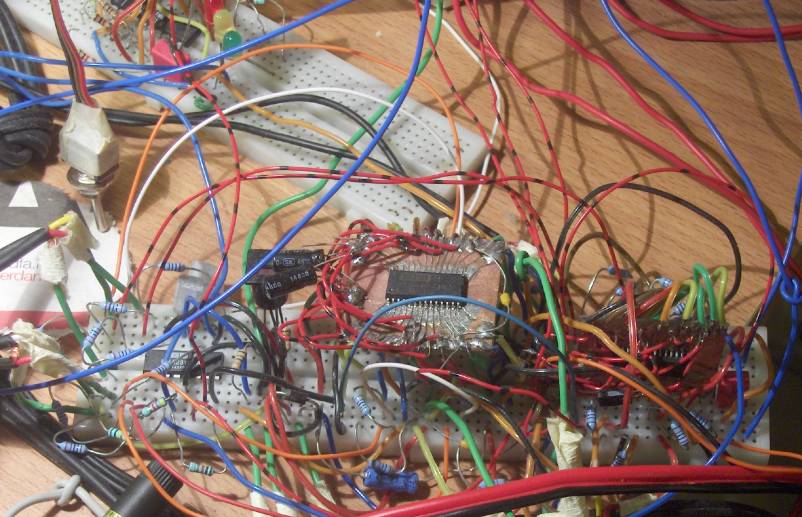
This 10 channel (5 channel stereo) mixer has been running in practice
for a long time and has very superior and satisfactory sound quality,
at least a 0dB. FOr further testing, I asked for some A grade parts,
and I'll make a soldered setup with more attention for signal shielding
and ground planes, which then could be a real good product prototype,
which I'll use myself. This setup was controlled by a computer parallel
port (with extra buffering) and of course suffered from some grounding
noise, depending on the connected equipment and the whole connection
setup.
5 Sliders based on a tcl/tk program on the computer screen would
control various sources to two destinations, which worked quite well,
and is a real relief and joy in comparison with those dreaded digital
volume controls. The sound is nice, tight, distortion poor (as I said,
at leasdt at around 0dB) noise poor, and the controls with the onscreen
(long throw) sliders works neat.
I asked (and received) some more samples because I want to try out the
effect of subsequent volume chips on a row (from the same and different
cases) and various mixer setups (the inputs require fairly low
impedance), and also I want to try tone controls, and maybe even DCA's
and compressor setups with these devices. Try to find a VCA with 0.0002
percent harmonic distortion somewhere, anywhere at al...
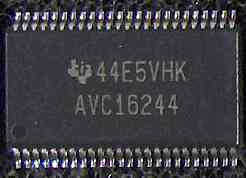
SN74AVC16244DGGR : 5 , Datasheet
16-Bit Buffer/Driver With 3-State Outputs

SN74LVC2G53DCTR : 8 , Datasheet
Single Pole, Double-Throw (SPDT) Analog Switch or 2:1 Analog
Multiplexer/Demultiplexer
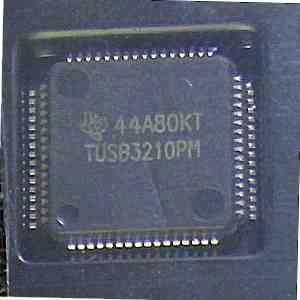
TUSB3210PM : 2 , Datasheet
Universal Serial Bus General Purpose Device Controller
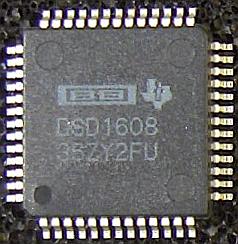
DSD1608PAH : 2 , Datasheet
24-Bit 8ch Multi-Format DAC
Well, I'll like trying this recent sample out, for instance on the
blackfin. * channels of very high quality, up to 192 kS/s, high dynamic
range DA converters with as it seems a standard PCM interface, that is
good. Multi channel sound, in principle DSD (Super audio CD) though I
have no source for that at the moment, and also I like the idea of
being able to use this as a control signal generator for in a analog
synthesizer: very accurate and more than a few channels. Let the Xilinx
do the bit pattern repetition and maybe interpolation.for envelopes,
frequency controls and such.
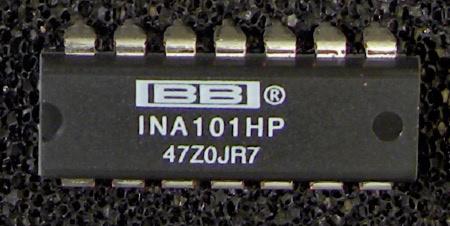
INA101HP 4 , Datasheet
Very High Accuracy Instrumentation Amplifier
This should be a pretty decent instrumentation amplifier according to
the specs, I want to use it to unbalance synth block signals such as
from a ladder filter (like the moog filter), maybe control signals, and
possibly for audio and measurement, though IIRC audio is not perfect
with it. I didn't really like the ina 103 for mircophone, maybe I
should compare.
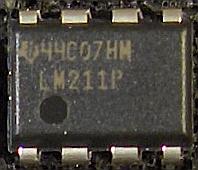
LM211P 5 , Datasheet
Single, Strobed Differential Comparator with Open Collector and Emitter
Outputs
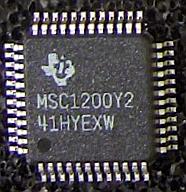
MSC1200Y2PFBT : 1 , Datasheet
8051 CPU with 4kB Memory, 24-Bit ADC, Current DAC, and On-Chip
Oscillator
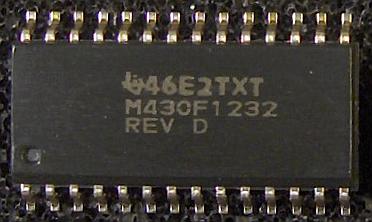
MSP430F1232IDW : 2 , Datasheet
16-bit Ultra-Low-Power Microcontroller, 8kB Flash, 256B RAM, 10 bit
ADC, 1 USART
This boy is popular for measurements in electronics land at the
moment, there is even a ethernet interface for it. I just downloaded
the TI open source IDE for it, and didn't get around to see how that
environment generates code or what programmer schematic diagram it
needs, but it seems like fun to find out what it needs to get set up
and run.
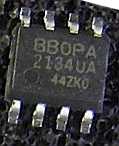
OPA2134UA : 5 , Datasheet
SoundPlus(TM) High Performance Audio Operational Amplifiers
Will try.
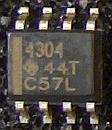
THS4304D : 5 , Datasheet
Wideband Operational Amplifier
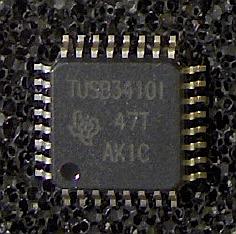
TUSB3410IVF : 3 , Datasheet
RS232/IrDA Serial-to-USB Converter
I found out this thing requires 24 instead of 27 MHz crystal, otherwise
I might have tried it out already, seems cool to connect a machine up
with its own USB serial interface, I already can use a serial flash,
that migh give it its own device serial number. Fortunately it requires
not the fines (most often needed) converter pad on a conrad adapter
board.
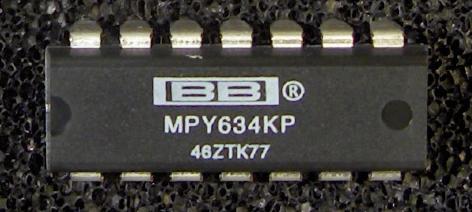
MPY634KP : 4 , Datasheet
Wide Bandwidth Precision Analog Multiplier
This will be fun: a multiplier in analog form, with at least usable
specs, but (as ever...) not really for high quality audio signal paths.
But, for a guitar amplifier simulation, and as decent modular synth
block, it will make a nice ring modulator, or VCA, or part of some
dynamic circuit with feedback, for all kinds of mathematical formula
solutions.
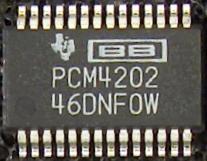
PCM4202DBT : 3 , Datasheet
24-Bit/192kHz, 118dB, Stereo Audio A/D Converter
As counter part of the above DSD DA converter, this is the best AD chip
I've seen advertised thus far, except for recently, when AD anounced
some like these, too. Self explanatory why I want to make a nice
prototype board for this honey: its harmonic distortion lies under the noise floor of most DA converters....
But I'm sure a little battle might be at hand to actually get it to
perform according to specs. Opto couplers in the digital signal path ?
5 mm grounded copper all around it ? Mu Metal seperated ultimate
balanced drivers as front end? We'll see. My power amplifier does over
a 100dB or so S/N, so it is possible.

PGA2311PA : 5 , Datasheet
+/-5V Stereo Audio Volume Control
The nice little A here makes the part about twice as linear as the
alternative I've tried already, and probably matters price-wise, too.
But then again: what does a good potmeter cost? Or worse: a decent
motorized fader ! I'll put these recently gotten parts on a board soon
and start tring all kinds of circuits with them, at least these are
easy to prototype (for me) DIP packages.
This package also has an alternative supply voltage, otherwise I migh
not have dared to ask for yet another bunch of these black boxes from
the sample division... It's good to have +-15 volts for dynamic range
in the tradition of decent mixers, but contemporary circuits often even
reduce to 5 Volts, which is easier and more portable.
The 4 channel parts (in bit smaller packages see below and elsewhere on
this list) don;t come in higher voltage variation, I wonder why for the
high voltage parts one has to go DIL.

PGA4311UA : 5 , Datasheet
4-Channel, +/-5V Audio Volume Control

SN74AUC1G66DBVR : 10 , Datasheet
Single Bilateral Analog Switch

TS5A3159DBVR : 10 , Datasheet
1-Ohm SPDT Analog Switch
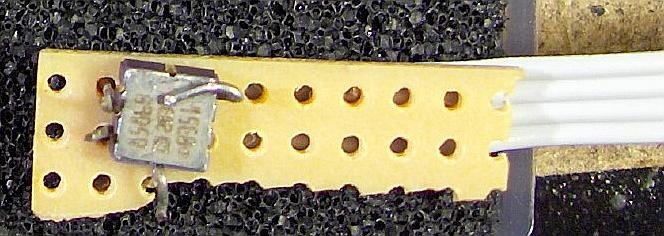
ADXL203CE : 2 , Datasheet
High Precision, ±1.5g, Dual Axis Accelerometer
Apart form application in model choppers, this is a top-fun to use
part: it measures acceleration. I've had to make a unperfect
contraption to hold it in place on a small piece of board and to let it
make contact, because officially it is a very difficult process to
solder the little thing, because the whole heating up and cooling down
porcess must take place over the course of 5 minutes or so, at a feq
degrees per 10 seconds or something. Ludicrous without the right
eqpment, so a basically clamp-connected it, which works.
When connected to supply and a multimeter, it nicely responds when it
is moved, the faster it is moved themore output votlage change. I
didn't yet get to trying it as a displacement meter by integrator use,
but it functions.
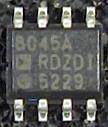
AD8045ARDZ : 2 , Datasheet
3 nV/sqrt Hz Ultralow Distortion Voltage Feedback High Speed Amplifier
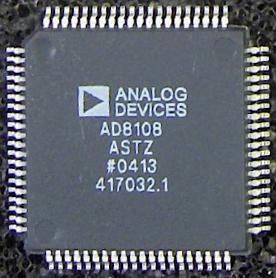
AD8108ASTZ : 2 , Datasheet
325 MHz, 8x8 Buffered Video Crosspoint Switch (Gain=1)
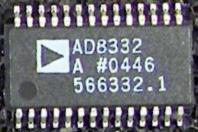
AD8332ARUZ : 2 , Datasheet
Dual VGA with Ultralow Noise Preamplifier and Programmable RIN
More then decent but not perfect audio range behavioru according to
datasheet, this recently gotten sample will be tried as VCO synthesizer
block, and maybe as OTA style VFC experiment.
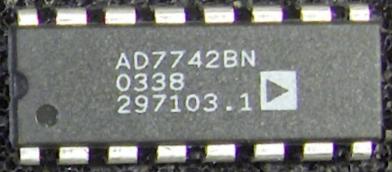
AD7742BN : 2 , Datasheet
New Low-Cost, Single-Supply, MultiChannel Synchronous VFC
Also recently gotten, this voltage controlled oscilator will serve as a
sample reproducing VCO core, by making a few megaherz VCO drive a
sample table lookup circuit which drives a fast DA converter, when it
is well behaved enough, that is. Alternatively, or simultaneously, it
may drive a switched filter.
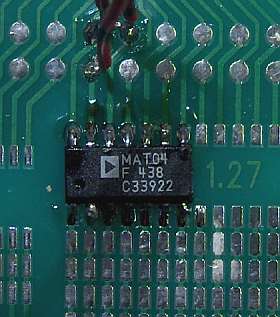
MAT04FS : 2 , Datasheet
Matched Monolithic Quad Transistor
A standard part from long, long ago. I recall in primary school (before
78) I read library books which mentioned chips with matched transistors
on it for good temperature stability.
The 4 transistors on this chip are matches in pairs, and as is shown
below have very good current amplification.
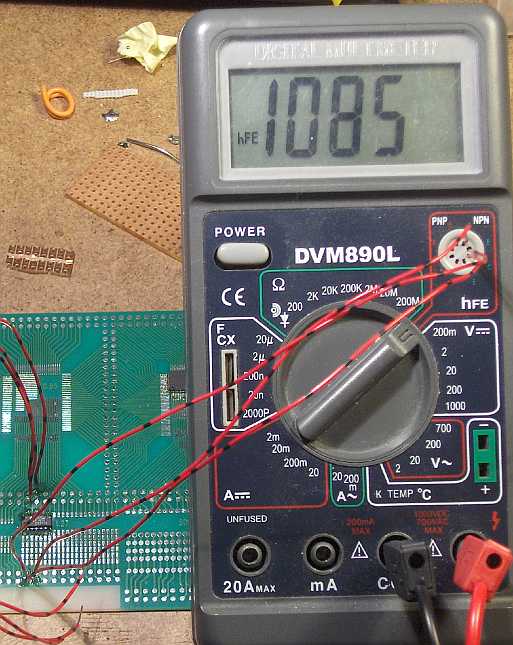
should be good for stable moog-type voltage controlled oscilators and
maybe filter currents.
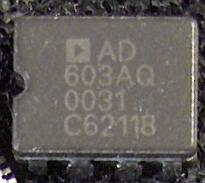
AD603 : 1 , Datasheet
Low Noise, Voltage-Controlled Amplifier For Use In RF And IF AGC Systems
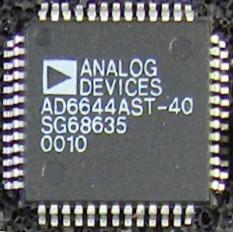
AD6644 : 1 , Datasheet
14-Bit, 65 MSPS Wideband Analog-to-Digital Converter

AD9772A
: 1 , Datasheet
14-Bit, 160 MSPS TxDAC+® with 2x Interpolation Filter

( ADCMP567BCP AD8343ARU MAT04FS These samples are in request, I
just received confirmation they are on their way with a Tnt tracking
number )
The ruler again is more or less to scale with most shown pictures.
Is there any use to all these, eh, chips? Of course! Below some test
setup, see also this Dsp page
and this Xilinx page which
connects a
fast digital signal processor board to external devices such as
displays and knob, as a start for a sound synthesizer prototype. Does
it all work? Yep, in principle all things I tried work.

What's with all these electronics and wires?
Well, for instance, they can tell you the time:
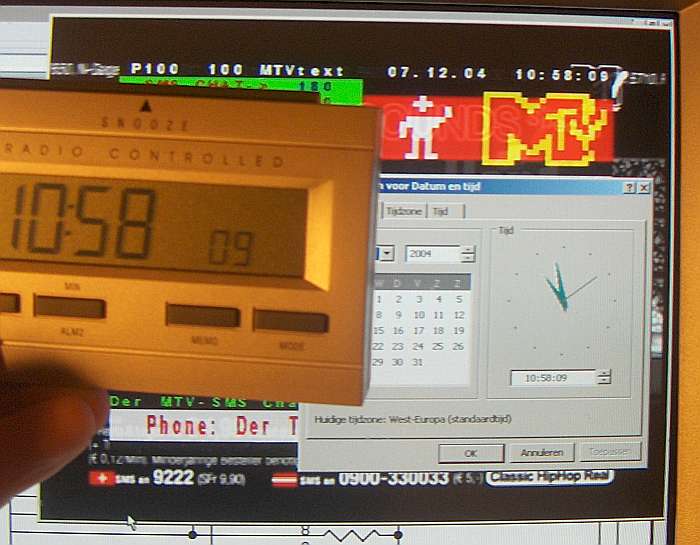
The picture shows three perfect enough ways to tell time with one
second accuracy, and any moment of the day: a radio signal controlled
clock, a microsoft time server synchronized windows XP clock, and a low
latency video window with satelite dish received MTV teletext clock in
the upper right corner, and guess what: they all display the same time,
all less then a second apart, without special tricks, I didn't set
those clocks, they were 'live' !
But before you can make all that work, a lot of wires have to be in
place, as example here the back of a computer I can use regulalry:
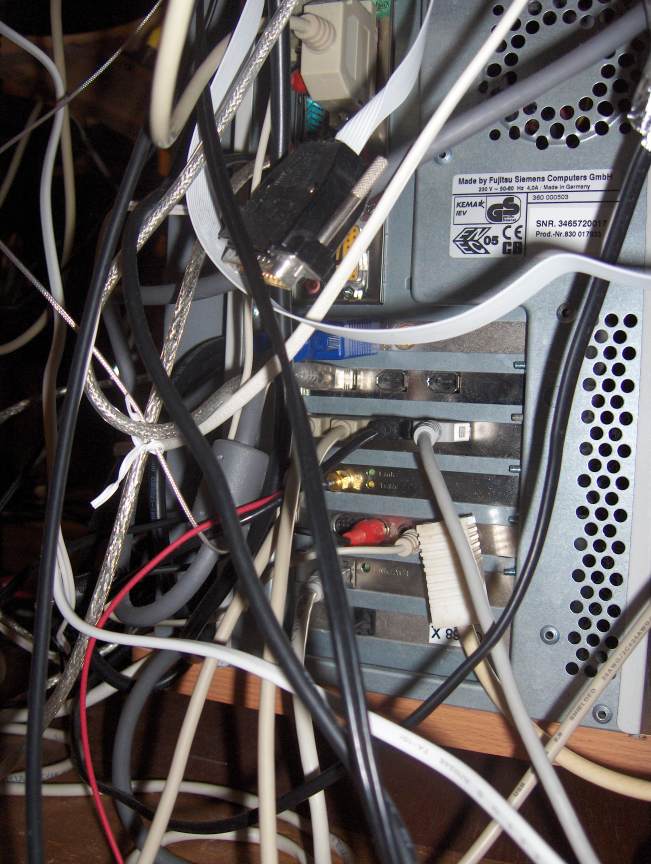
What's in there, and does it work? Well, lets see, and yes, it all
works, and in fact it isn't by far all.
From top to bottom:
The power cord and mouse and keyboard plugs
A parallel cable to either and experimentor breadboard, or a Xilinx
programming interface JTAG plug, and when it was in used, alternatively
to a parallel port controlled sound mixer prototype.
A serial cable to either a blackfin DSP board or a Ananlog 7020 Arm
microcontroller mini-board (as programmers/communication interface) ,
and possibly to other microcontrollers, using a MAX232 level converter
chip.
A builtin soundcard connection set (currently not in use except for
low-fi speakers to 'bleep' when the sound system is turned off), and a
MIDI connector (not often in use, but there is a fully operational
keyboard for it)
A ground connection (with little clamp) for grounding a peron working
at connected electronics against electrostatic charges.
A monitor connector
Two USB1 (low speed) connections (invisible), one dedicated to ADSL
modem, the other connected to a 4 out USBII hub, which holds: pinter,
webcam, and high quality audio USB AD/DA converter 1 and 2.
IEEE1394 Firewire connections to fast local network and video camera
connection
4x USBII (fast USB) to: streaming MPEGII digitizer, blackfin EZLITE
bf533, idem BF561 (dual core) , USB-Midi (to synthesizer),
alternatively to a photo camera output or a video camera photo
card-reader output
A wireless network (wifi) connector to antenna
Video (second video input) connections to: antenna, video input (from
VCR or camera or satelite), remote control, sound output to mixer
LAN connection with 100baseT UTP ethernet cable
modem phone connection (unused)







 Flowers I shot in an
Amsterdam park some time ago, I think is was rainy and I used fill-in
flash.
Flowers I shot in an
Amsterdam park some time ago, I think is was rainy and I used fill-in
flash. The
dutch minister president in a cartoonish pamphlet indicating with the
kind of electrical machinery high voltage sticker that 'holland
deserves better'....
The
dutch minister president in a cartoonish pamphlet indicating with the
kind of electrical machinery high voltage sticker that 'holland
deserves better'....
















































